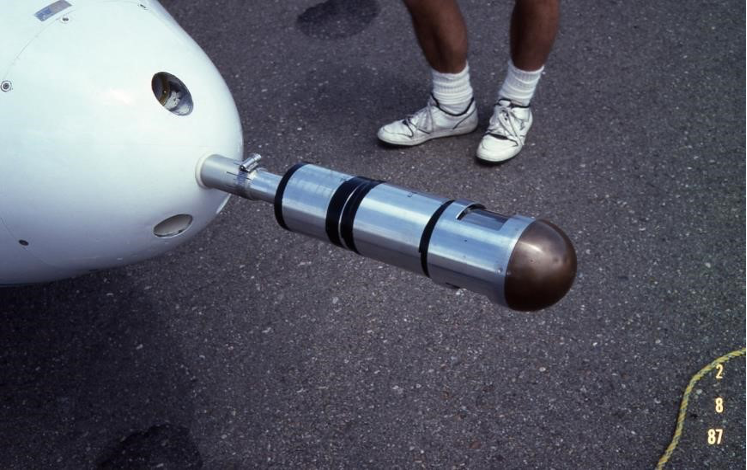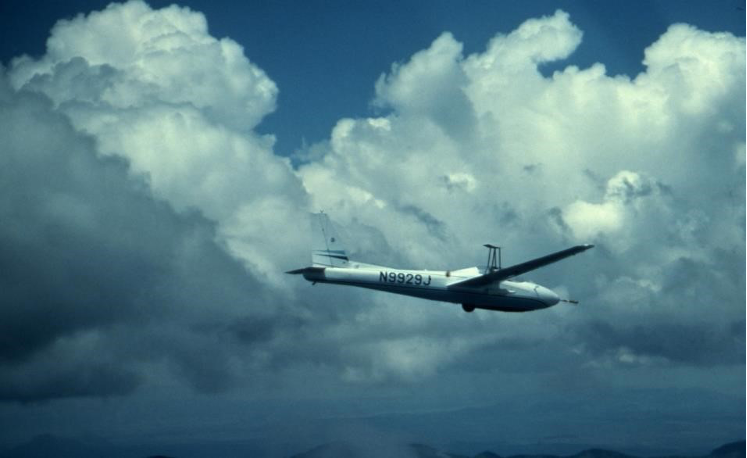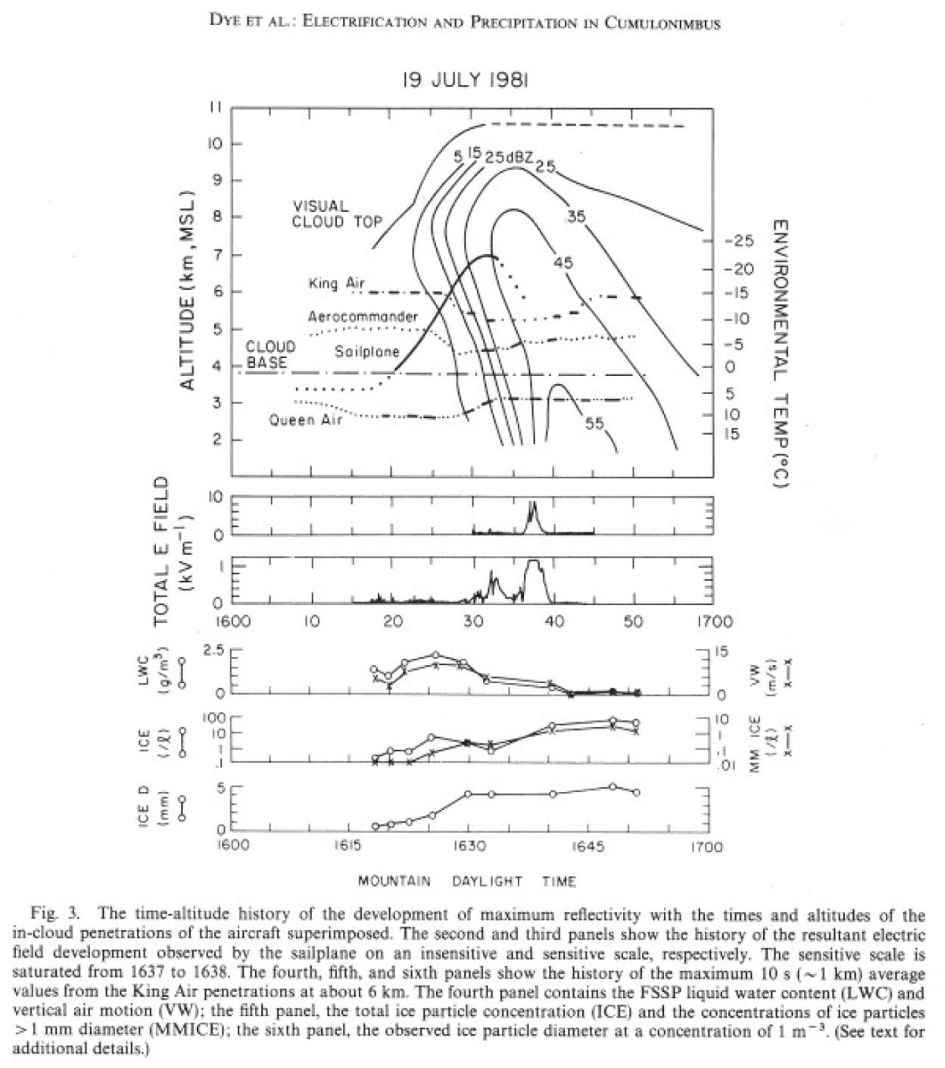There are numerous mechanisms which can potentially contribute to the electrification of clouds. For review of the many mechanisms and observations in thunderstorms see Chapters 3 and 7 in the book The Electrical Nature of Storms by MacGorman and Rust, 1998. Even in the mid 1980s there was no consensus on the main mechanism that could electrify storms sufficiently to produce lightning. Introductory material in The Earth’s Electrical Environment published in 1986 by the National Academy Press states: “The updrafts and downdrafts and the interactions between cloud and precipitation particles act in some still undetermined manner to separate negative and positive charges within the cloud.” Many investigators thought precipitation-based mechanisms involving collisions and separation between precipitation particles were probably the primary source of charge separation in storms. But it was not clear if the main mechanism was an inductive process whereby the magnitude of charge transfer between colliding and separating particles is dependent on the strength of the electric field. Or was it a non-inductive process of collision and separation of graupel with ice particles whereby the magnitude of charge transfer is independent of the strength of the ambient electric field. Others yet thought that a convective mechanism whereby ions outside the cloud migrate in the ambient electric field, attach to particles in the cloud and then are separated and transported inside the cloud in such a manner as to enhance electric fields. The theories could not be effectively tested because of a lack of observations of particle concentrations and types along with reliable electric fields inside clouds as they become electrified. Likewise, the measurements that were available were not coordinated with simultaneous Doppler radar measurements to determine the overall precipitation structure and air motions in the cloud as it became electrified. Because of its ability to spiral in the updraft and remain in the cloud for extended periods of time to monitor the evolution of particles and fields, Explorer was an ideal platform to investigate these relationships. When coordinated with Doppler radar these observations could be put into the context of the cloud structure and air motions in the cloud.
Airborne measurements of electric field in-cloud using aircraft are extremely difficult because the aircraft acquires a charge due to the impaction of both water and ice precipitation particles on the aircraft wings and body and for powered aircraft charge is also exhausted by the engines and when in cloud, from the tips of the propellors. The charge on the aircraft due to impaction of hydrometeors on the airframe can be very much larger (as much as a factor of a hundred or more for weakly electrified clouds) than the ambient electric field. (Jones, 1990). Any attempt to measure the ambient electric field must compensate for this aircraft self-charging which can be hundreds of times more than the ambient electric field. A sailplane has the advantage of not charging due to engine exhaust or from charge thrown off by propellors. Additionally, the symmetry of sensor locations about the nose of the sailplane simplifies the calculation of the ambient electric field. A sailplane also can obtain continuous measurements of the electric field as the sailplane ascends in the cloud thereby obtaining high time resolution of the electric field build up in the cloud.
In the 1960s and 1970s cloud electrification was an integral part of cloud physics. B. J. Mason, Roland List, John Latham, John Hallett, and Peter Hobbs, their students and others conducted experiments on cloud electrification. However, as mentioned above, there were few in-cloud observations to test the various ideas. Even before involvement with Explorer, Doyne Sartor had an interest in cloud electrification. Consequently, there were some attempts in the early 1970s with Explorer to make measurements of the ambient electric field using radioactive polonium probes. Jim Dye, having been a student of Peter Hobbs, also had an interest in cloud electrification. Analysis of the polonium probe measurements by Dye and a student, Richard London in the mid 1970s showed an oscillatory pattern associated with the spiraling of the sailplane and suggested that the horizontal fields were larger than the vertical fields. This was contrary to the usual expectation that the vertical electric fields should be larger. In 1979 the sailplane was flown with its microphysical instruments and radioactive electric field sensors near Socorro, New Mexico to investigate the microphysical structure of clouds forming over Langmuir Laboratory. This was a collaborative effort as part of the Thunderstorm Research International Project (TRIP). Small thunderstorms form almost daily over Langmuir Laboratory near the top of Mt Baldy at 10,700 feet in the Magdalena Mountains of central New Mexico. Langmuir Lab has been operated by the New Mexico School of Mining and Technology (NMT) since 1963 for the study of lightning and electrification of storms. In preparation for taking Explorer to New Mexico new 3-axis radioactive probes were designed, built, and mounted on a nose boom protruding from the front of the sailplane.
During the project in New Mexico in a conversation between Dye and Bill Winn of NMT about making electric field measurements from aircraft, Bill told Jim that the atmospheric electricity community would not believe measurements made with radioactive devices. If the sailplane measurements of electric field were to be believed they would need to be made with a field mill type device. In response Jim replied: okay, would you be willing to design and build a field mill device and collaborate with us in flying it on Explorer. The resulting Kasemir-type design mounted on a boom extending from the nose of the sailplane is shown in Fig. 26. It measures two components of the electric field: top-bottom and left-right. This rotating, cylindrical field mill was designed for and flown on Explorer during the Cooperative Convection and Precipitation Experiment (CCOPE) in SE Montana in 1981. Dan Jones, formerly at the Univ. of Arizona, was hired by NMT to work with the field mill system on Explorer.
Fig. 26 Top: Photo of the rotating cylindrical field mill built by Bill Winn and Dan Jones of New Mexico Tech for Explorer.
Bottom: Photo of Explorer flying in New Mexico with the NMT field mill.
CCOPE was a highly organized field program with 14 aircraft and several doppler radars participating with the goal of investigating the dynamical and microphysical characteristics of storms over the great plains. (Knight, 1982) It was a collaborative effort between NCAR, the Bureau of Reclamation and many university groups. For the first time, in CCOPE Explorer had the capability of measuring both the microphysical content and the electric fields in cloud as the sailplane spiraled upward in the updraft.
The new measurement of electric field on the sailplane and the collaborative use of many aircraft to investigate and document the conditions within towering cumulus clouds is demonstrated in Fig. 27 which schematically shows the vertical ascent of Explorer overlaid on the radar reflectivity evolution in a building storm. As the sailplane ascended in the updraft, simultaneously the University of Wyoming King Air was making passes above the sailplane and then below the sailplane; the Desert Research Institute Aero Commander was making passes in the lower part of the cloud; and the NCAR Queen Air was making passes to monitor conditions below cloud base.
Fig. 27. A copy of the original Fig. 3 in Dye et al. (1986).
Fig. 27 shows the slow build-up of charge beginning near 1629 reaching a peak near 1632 of about 800 V/m as the sailplane spirals continuously in the cloud. Shortly thereafter Explorer left the cloud, turned back and made a pass on the very edge of the cloud. As Explorer approaches the cloud there is a rapid increase in field with a peak of about 9 kV/m near 1637:30. The spike and the rapid decrease in the insensitive plot (top panel) of the electric field at ~1637 indicates the occurrence of lightning. At about the same time the Desert Research Institute Aerocommander aircraft flew through the cloud at 4.5 km (-6 oC) from 1635:30 to 16:36:30 measuring an electric field of 15 kV/m at 1636. (Not shown, but see Fig. 10 in Dye et.al., 1986). The King Air measurements in the lowest three panels of Fig. 27 show that at -10 oC inside the cloud there were both small and large ice particles and graupel (not shown) as well as supercooled liquid water. Overall, the combined measurements showed that 5 mm graupel particles existed in the cloud before the electric field begin to build and was consistent with a non-inductive charge separation mechanism. Also, the cloud produced 8 to 9 mm graupel which were of sufficient size and concentration to explain the observed reflectivity of ~ 40 to 45 dBZ. See Dye et al. (1986) for additional information.
- Explorer Participation in the National Hail Research Experiment (NHRE)
- Precipitation Formation via the Ice Process in NE Colorado
- The Discovery by Explorer of Adiabatic Ascent in Clouds of the High Plains
- Discovery of Penetrative Downdrafts
- Observation of a Counter Rotating Vortex Pair in a Cumulonimbus
- Explorer Observations of Silver Iodide Seeding in Cumulus Clouds
- Studies of Initial Cloud Electrification with Explorer
- Electrical/Microphysical Measurements in New Mexico
- Measurements on Explorer of Particle Charge, Size and Shape
- Flight in New Mexico to 40,200 ft with Particle Image and Charge Measurements
- Results from CaPE in Florida in 1991


